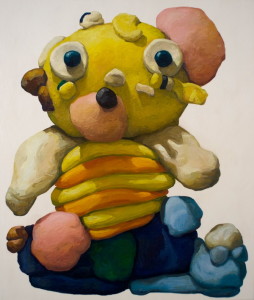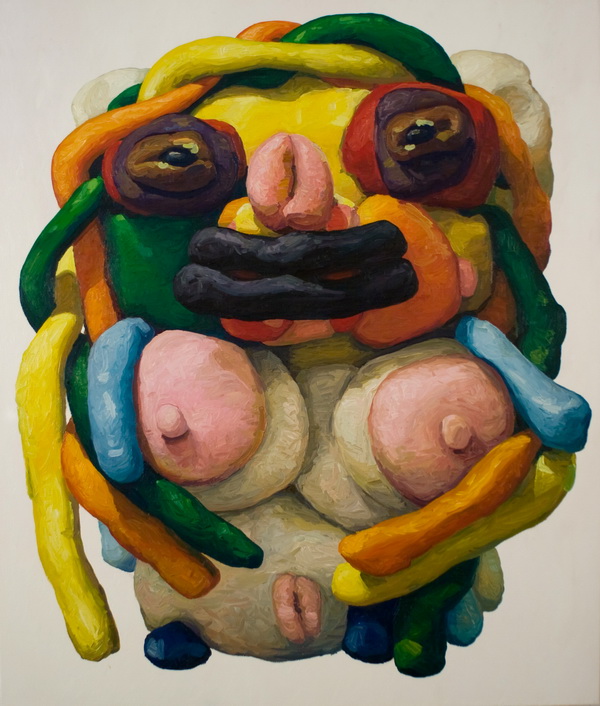In 2011, Peter Opheim abandoned abstraction and began sculpting small maquettes out of colored clay, which he’s continued to transform into monumental oil paintings that uncannily capture the sculptural quality of his small-scale models. Most of his initial pieces depict whimsical creatures that one might find on a Claymation series for children. Like pre-school Play-Doh figurines, these early figures aggregate body parts that resemble rolled balls and tubes of clay, stacked and attached in ways that summon a childhood sentimentality and association with familiar cuddle toys.
For his new exhibition at Zevitas Marcus titled “Fables of the Eleven Rooms and Six Houses,” Opheim presents a new series of 11 large-scale paintings along with six three-dimensional works. Again, his paintings embody a childlike essence. What sets these works apart, however, is that they shatter any idea of whimsy or nostalgia with images that manifest as grotesque and mutated. Evolving beyond the saccharine sweetness that characterized his previous paintings, Opheim’s show instead embodies complex notions that speculate on the inner workings of the pre-adolescent’s mind, navigating adult territory with only a limited knowledgebase grounded in fantasy.

Peter Opheim, Untitled no. 288, 2016. ©Peter Opheim, courtesy of Zevitas Marcus Gallery, Los Angeles.
Like Mike Kelley’s soiled stuffed animals, Untitled #288 (2015) succinctly iterates the fracturing of innocence. Looking like an old teddy bear that has endured years of love and wear, the “plush toy’s” nose is askew, one pink ear is missing and several barnacle-like growths cover its face. More ominous are Untitled #293 (2016) and Untitled #286 (2015). While neither assumes any recognizable form, both possess basic facial features: two eyes, a nose and a mouth. What makes these works distinctive, in comparison to Untitled #288, is that they feel so intrinsically organic, like original works by young children rather than reimagined children’s toys, which holds true for the remaining works on view.
Among other creatures featured in the show, several yield a host of peculiar and even freakish constituents. Untitled #294, for example, looks like a toddler’s interpretation of Medusa; long rolls of yellow and white clay are coiled into spiraling eyes, while bands of pink, red and blue add to the array of appendages that extrude from the figure’s head and body. Likewise, Untitled #285 plays with the idea of interpretation from a naïve perspective. The figure is an unclothed woman with big, brown Tootsie Roll lips and rounded breasts made from flattened circles, piled like stacks of pancakes.
Also of note are the six intricately constructed sculptures that accompany the show, made from the discarded clothing of the artist’s friends and family. These, Opheim refabricated into stuffed animals, which, unexpectedly, read more two-dimensionally than his paintings. Appearing like deflated pool toys atop white square pedestals, each the approximate size of one of Opheim’s canvases, they undeniably indulge further musings about childhood innocence. Even more, however, their presence creates a unique juxtaposition that leaves viewers contemplating the function of sculpture, in relation to painting, as well as each medium’s capacity for aesthetically communicating Opheim’s intent.


